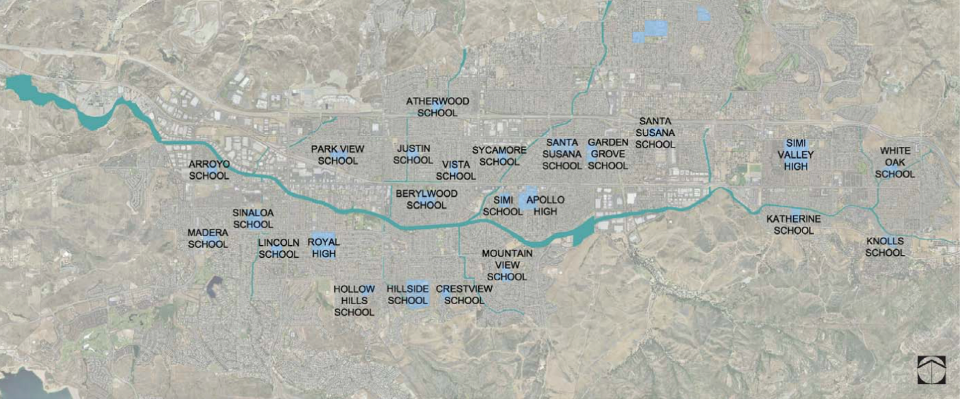As California ATP Cycle 5 Kicks Off—Here’s a Snapshot of Some Success Stories

On March 26, California released a call for projects for the next round of the Active Transportation Program (ATP)—the state’s largest single source of funding for trails and walking and biking projects.
Since the ATP launched in 2014, nearly $1.5 billion has been allocated to over 800 active transportation improvements, with about one-third of that funding going to trails and protected bikeway projects. This substantial investment has catalyzed transformative changes in cities and towns across California to create more walkable, bikeable communities and expand equitable opportunities for recreation, active transportation, economic growth, public health and environmental sustainability.
ATP Cycle 5 Funding
Cycle 5 of California’s Active Transportation Program (ATP) has $445 million available for the fiscal years beginning in 2021–22 and through to 2024–25. Currently, applications are due by June 15, 2020, although the California Transportation Commission (Caltrans)—the residing grant operator—may decide to extend the deadline due to the COVID-19 crisis (a decision will be reached in May). Access the ATP guidelines and subsequent updates on the Caltrans website.
As the new round of ATP gets underway, RTC checked in with some communities around California with ATP-funded trail projects to learn how they’ve been making progress over the past couple years. Here’s a great snapshot of their transformative work underway.
Downtown Roseville Bridges and Trail Project

Some 4,500 people gathered in Downtown Roseville on Saturday, Sept. 21, 2019, for “Celebrate Downtown,” the official grand opening of the city’s Downtown Bridges and Trail Project, which focused on the completion of 6 contiguous miles of the beloved 7.5-mile Miners Ravine Trail, a paved Class 1 trail along Dry Creek. Attendees, which congregated in the 176 acres that comprise the Historic Old Town, Vernon Street District, and Royer and Saugstad parks, kicked-off the lively event with a ribbon-cutting ceremony and ride along the new segment of trail, which helped to close an important gap and now provides vital access between neighborhoods, businesses and downtown for the rapidly growing suburb 15 miles northeast of Sacramento.

As part of the project, the city relocated and made physical improvements to the 40-ton, 180-foot long historic Rube Nelson “Ice House” Bridge—which involved repositioning the bridge with a 550-ton crane to connect the bike trail across Dry Creek, according to Helen Dyda, a spokesperson for the City of Roseville.
ATP funds also supported the construction of the Library Bridge, which now connects the Royer Park Bike Trail—a segment of the Miners Ravine Trail—to a transit stop next to the Downtown Roseville Library.
Building a network of trails to make it easier to safely walk and bike around the city is a primary focus of Roseville’s future infrastructure planning. As a result of these transformational projects, Roseville expects to see a surge in bicycle ridership during its next rider count later this spring.

Humboldt Bay Trail: Arcata Rails with Trails Project

In Cycle 1, the ATP awarded a $3.1 million grant for the City of Arcata Rails with Trails Project, a 3-mile trail completed in 2017. In addition to connecting trails in the surrounding area, the project comprises the initial section of the 14-mile developing Humboldt Bay Trail—itself is part of the larger 316-mile Great Redwood Trail, which will one day connect the Bay Area and the North Coast.
According to Arcata Assistant City Engineer Netra Khatri, the Arcata Rails with Trails Project took 12 years to complete due to challenging environmental factors. Traversing four bridges developed exclusively for trail users, progress during the trail’s construction phase could only be made during low tides and summer months due to the marsh and sea-level landscape near the bay.
Since the trail’s completion, it has been embraced by walkers, bicyclists, roller-skaters, birders and tourists enjoying the bay views, with two counters recording some 400 to 500 weekend users alone in the 2019 trail season (May to September)—strong numbers for this rural community.

Simi Valley Arroyo Simi Greenway Bike Trail (Phase 3)

After only 2.5 years on the ground, the third phase of the Simi Valley Arroyo Simi Greenway Bike Trail has become a popular active transportation and recreation connection, and safe route to school, in the southern California community. Prior to receiving Cycle 1 ATP funding, the greenway—which travels east–west for 12 miles through the City of Simi Valley—was surfaced mostly with gravel and was used primarily as a maintenance access road by the Rancho Simi Recreation & Park District (RSRPD).

ATP funding enabled RSRPD to develop a fully paved, accessible trail that now connects users to 13 public parks, 24 schools and several commercial properties within a 2-mile radius of the trail. RSRPD also placed historical and interpretive information along the trail to educate users on health-related and environmental topics relevant to the region.
The completion of the Greenway allows students in the Simi Valley community to travel to school safely and offers walking field-trip opportunities for schoolteachers.
“We have noticed, since the sections of the Arroyo Simi Greenway renovation, more people walking, biking and exercising, confirmed Rancho Simi Recreation & Park District Landscape Designer Douglas Duran.

Alameda Central Avenue Complete Street Project
Having received a $7.3 million Cycle 3 ATP grant in December 2016, the City of Alameda—an island city in the San Francisco Bay—is in the process of formally initiating its Central Avenue Complete Street Project with Caltran.
The proposed bikeway on Central Avenue is a component of the City’s Bicycle Master Plan Update, in which it is seeking to reallocate space for non-motorized modes of transportation and ultimately make the streets safer for pedestrians and bicyclists.
Involving a three-lane concept, including two travel lanes and one center-two-way left-turning lane, the final design and construction of the project is expected to take place in 2021 (with the city required to study the impact of the project on adjacent historical properties throughout the planning stage).
Located in a school- and park-dense area, the Alameda Central Avenue Complete Street Project will greatly benefit the community by improving connections to these destinations for vehicle drivers and active transportation users alike—providing a Class II bikeway with four- to three-lane conversion between Eighth Street and Encinal Avenue/Sherman Street, and a Class IV two-way bikeway on the south side of Main Street/Pacific Avenue, said Gail Payne, senior transportation coordinator for the City of Alameda.
She added that support has come from adjacent property owners, the school district, the ferry operator, and many local pedestrian and bicycling advocates.

Technical Assistance Resources
As part of Rails-to-Trails Conservancy’s (RTC) commitment to equity and active transportation in California, RTC is working in collaboration with Caltrans to provide no-cost training workshops and proposal-writing support to 10 disadvantaged communities seeking ATP Cycle 5 funding.
Our technical assistance team includes the nonprofit Local Government Commission and the transportation planning firm Fehr & Peers. While the communities have already been selected, there are many technical assistance resources available through the Active Transportation Resource Center.
More Success Stories on the Horizon
Inspiring trail development stories—such as those shared by the cities of Roseville, Arcata, Simi Valley and Alameda—are building excitement around trail development in the Golden State. After seven years of ATP funding, many California communities are seeing their hard work pay off in the form of smiling families biking and walking to school, work, public parks and local stores.
The first four cycles of ATP funding have already contributed to the groundbreaking of over 1,800 miles of trails, bikeways and sidewalks throughout the state—and as California continues to invest in active transportation, we look forward to supporting this effort to create healthier places for healthier people.

Donate
Everyone deserves access to safe ways to walk, bike, and be active outdoors.


